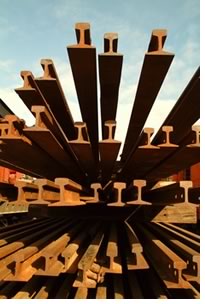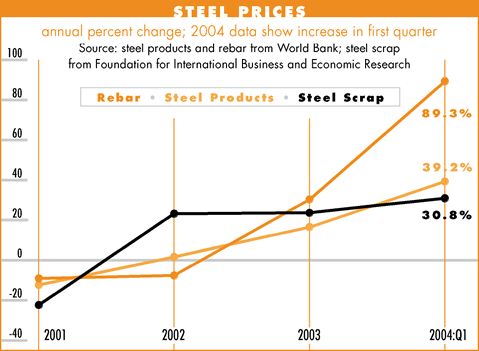

What’s Going on
With Steel Prices?
Architects also at risk with uncertain steel
market
Most architecture firms are not suffering from the fallout of rapidly escalating steel prices to the same extent as steel fabricators and nonresidential and heavy-construction contractors who work on fixed-price projects. Still, more aspects of our daily activities are intertwined with the steel situation than many would have thought.
An AIArchitect poll conducted beginning April 5 shows how vulnerable we are to rising costs of steel or, for that matter, any commodity used in construction. Readers reported bidding and construction delays as contractors and owners were sorting out rising costs or waiting for delivery of steel products.
 However, there were
several reports of rising steel costs hitting architecture firms more
directly. As owners began to realize that construction costs would inevitably
rise, some put design activity on hold to sort out the problem, while
others asked their design team to adjust programming and design for a
project to compensate for the inevitable higher costs.
However, there were
several reports of rising steel costs hitting architecture firms more
directly. As owners began to realize that construction costs would inevitably
rise, some put design activity on hold to sort out the problem, while
others asked their design team to adjust programming and design for a
project to compensate for the inevitable higher costs.
A few architecture firms reported unforeseen positive consequences from the situation, such as clients accelerating project timetables to beat future price hikes or delivery delays. However, even some of this apparent good fortune was a mixed bag, as workloads at many firms have picked up enough in recent months that they were having difficulty accelerating schedules.
Reasons for rising prices
In recent years, the construction industry has had to learn to cope with
volatile prices in materials. There have been several framing lumber spikes
over the past decade, and recently we’ve seen extreme pricing volatility
in wallboard, plywood, and copper. There is so much fluctuation in oil
prices that we’ve come to take it for granted.
Steel prices, however, have been unusually stable. Between 1960 and 2000, a four-decade period during which we saw several inflationary waves in our economy, the U.S. Department of Labor reports that producer prices for a broad market basket of construction materials increased 335 percent. Average prices for all commodities used in our economy increased by 261 percent over this same period. Prices for steel-mill products, however, increased by only 179 percent.
Steel was often pointed to as the good citizen of stable pricing. When framing lumber prices began to fluctuate dramatically during the late 1990s, some residential contractors turned to steel studs as a way to assure more stable prices and availability.
In addition to its historical stability, steel’s prevalence in construction projects makes its impact felt broadly. McGraw-Hill Construction estimates that 5–10 percent of the construction costs of a typical office building are from steel alone. Steel accounts for a significant share of construction costs throughout the commercial, industrial, and institutional construction sectors.
As is typically the case with price bubbles, the sources run across a broad range of supply and demand factors: disruptions in supply, bottlenecks in the system, and speculator-induced inflation. There is also strong international demand, particularly from China, which produced about 30 percent of the world supply of steel in 2003 but consumed more than 35 percent. And the Chinese demand is only going to increase—by nearly 20 percent per year in 2004 and 2005, according to the World Steel & Metal News forecast published in January.
Steel producers around the world are scrambling to increase production, but the quick spike caught most producers flatfooted after 10 years of steel-market malaise. One exception may be with U.S. steel producers, who had a 20-month head start on investing to improve productivity thanks in large part to a tariff on steel imports the Bush Administration imposed in 2002. The president reluctantly lifted that tariff last December in response to European and Asian complaints to the World Trade Organization.
There also are a few unusual pricing issues in this bubble: A falling dollar has raised prices for imported goods, most steel is imported these days, and ocean freight rates are increasing dramatically. (As a commodity, steel is particularly high in weight compared to value.) Also, as steel prices were edging up last year, steel mills tied prices to the cost they pay for scrap steel, which has historically been quite volatile.
How long the surge in steel prices will last is a matter of considerable speculation. The April 15 edition of The Wall Street Journal reported a drop in the surcharge steelmakers have been adding to their base steel prices since January 2004. Those surcharges currently add about $120 per ton to the base price for hot-rolled steel. With the current supply of scrap steel up and Chinese demand for it stabilizing, steelmakers seem ready to reassess the situation, which may mean higher base prices and eventual elimination of the surcharges. The cost may be stabilizing, but most likely at the higher prices we’re now experiencing.

What a volatile steel market means for
the profession
While higher steel prices can have a serious negative effect on a construction
project, in most cases it is the uncertainty that causes the most serious
problems. Higher steel costs, while causing hardships, can be factored
into the planning process. What is more difficult to factor in is the
uncertainty surrounding when—or whether—the steel components
will be available for a project.
There are signs that the worst of the steel price bubble is behind us; that prices will begin to moderate—although probably not collapse—later this spring. However, most architecture firms don’t want to be in the business of commodity price speculation, so there are some steps that can help them cope with this situation.
- Determine steel content of projects. The degree of exposure to steel pricing will in part depend on the material content of projects. Conveying this information to clients will help you get a sense of what the client thinks about the situation and demonstrate your sensitivity to the situation.
- Monitor steel pricing. Check with suppliers frequently to determine their pricing changes and how long they are willing to hold a quote. As suppliers see prices begin to stabilize, and deliveries become more regular, they will be more willing to guarantee a price for a longer period of time.
- Check with contractors. How are they managing their risk on rising steel prices? Are they adding in materials cost escalators or not quoting firm prices for steel products? This information will reduce the surprises when a project goes out to bid.
- Communicate with clients. What is their strategy for dealing with higher steel prices? Do they fully understand the likely cost implications on a specific project? What options can you offer early on to control their construction costs?
Copyright 2004 The American Institute of Architects.
All rights reserved. Home Page ![]()
![]()
 |
||
|
|
||